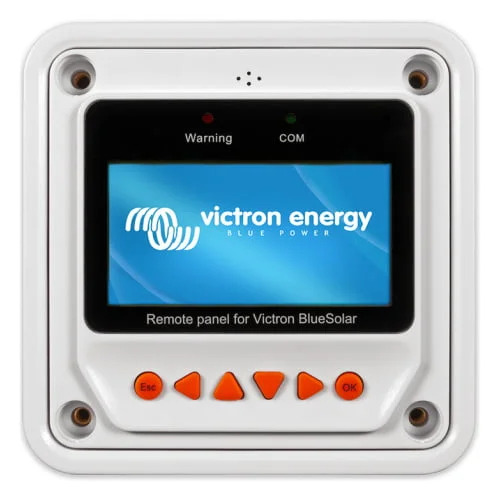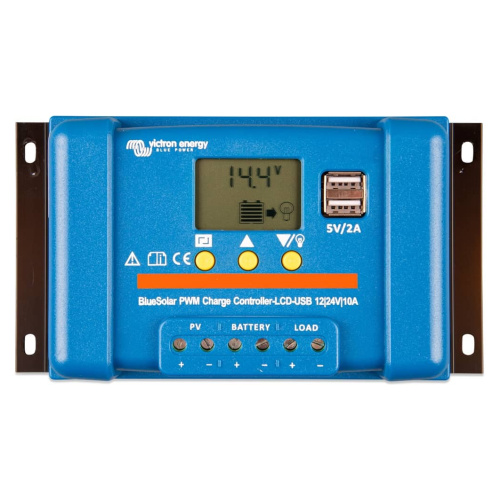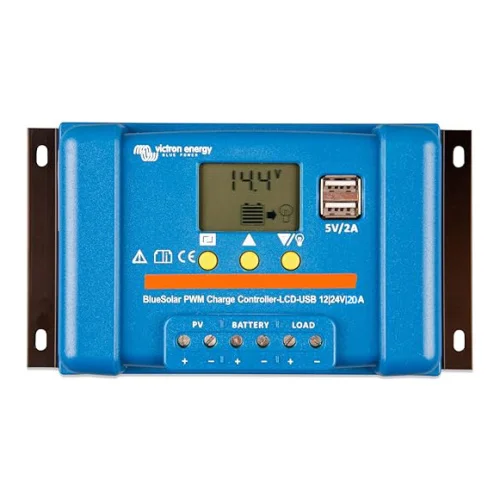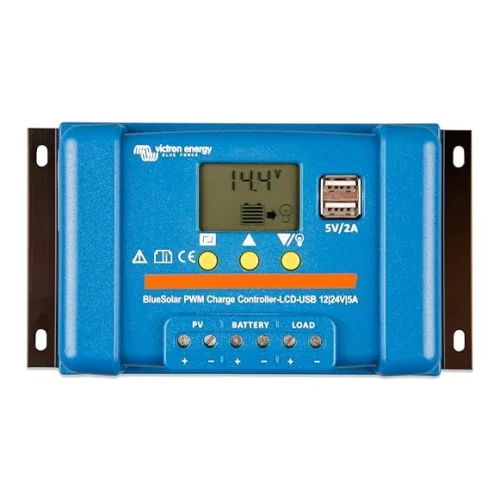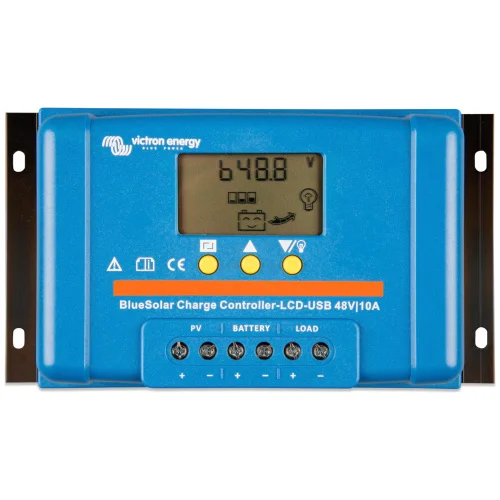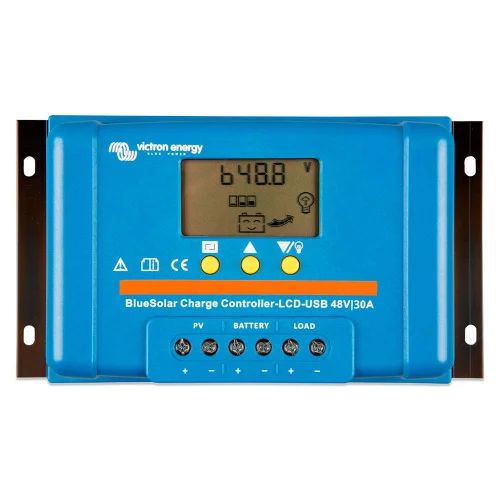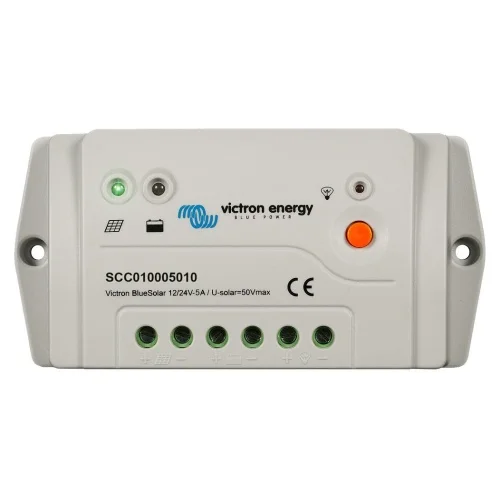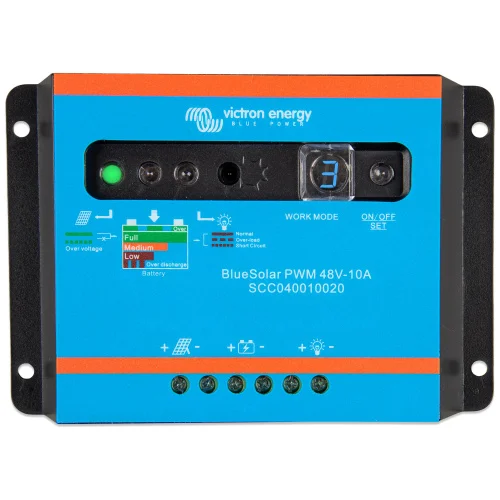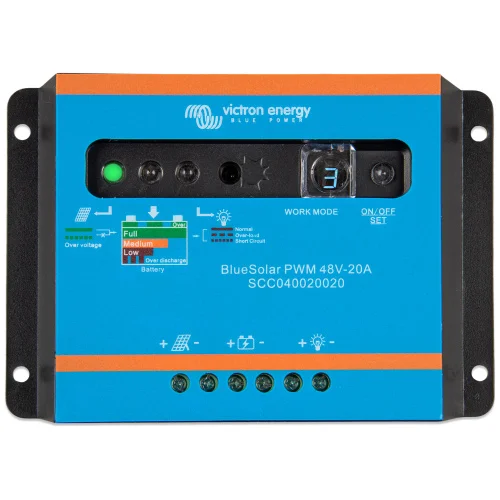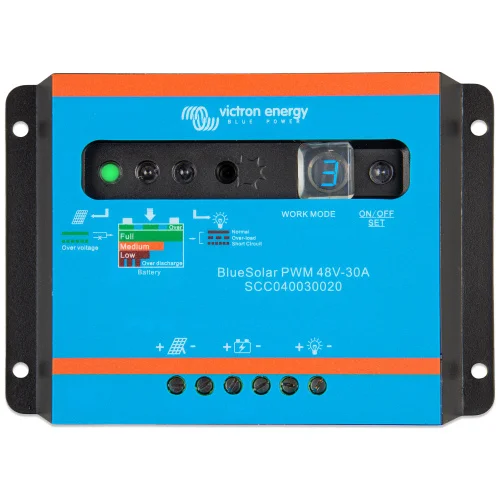- Free shipping to mainland Spain for orders over 300€.
PWM controllers
Buy your Victron solar charger – Victron pwm charger at the best price in our online shop specialised in Victron Energy. If you have doubts about how to configure your Victron inverter charger you can contact us or contract Victron remote technical support. Remember that we can also offer Mastervolt technical support and advise you on your installation.
PWM controllers
The pwm regulators are perfect for controlling the amperage of a photovoltaic installation. Thanks to the pwm regulator, the system will not always work at its maximum voltage, which can extend the life of the entire installation.
A pwm charge controller is installed between the solar panel and the battery. In the path of the energy from the solar panels to the batteries, the PWM regulator is used to ensure that the batteries are charged in an optimal and stable way. The pwm regulators are essential elements for our photovoltaic installation with batteries.
The pwm charge regulators are responsible for limiting the output of the solar panels in terms of amperage. In this way, the PWM regulator does not always work at maximum voltage and, therefore, obtains a constant power that is compatible with the batteries of the installation. PWM stands for Pulse-Width Modulation and is capable of modifying the duty cycle of a power source with a periodic signal with a constant signal.
The pwm solar regulators allow the solar panels to operate at the same voltage as the batteries, so that the installation does not operate at its maximum power. In this way, no energy or power is lost. By using a PWM regulator, the batteries can be filled to the maximum gradually, with voltage pulses and providing an optimal and stable charge.
Operation of a pwm charge controller
Working voltage: The predominant operating voltage in the system is that of the batteries and the PWM regulator is necessary for this. This may cause the solar panels to lose efficiency, but improves the overall performance.
Battery charging: The energy captured by the solar panels is used to charge the batteries. To do this, it must have passed through the PWM regulator so that the energy is compatible with the voltage of the batteries.
The pwm regulators charge the batteries gradually and are more gentle in the float phase, which prevents overcharging and damage.
Choosing the right Victron pwm
First of all, there are a number of technical aspects of a pwm regulator that must be taken into account:
- Voltage of the solar panels. With a PWM regulator, 12V or 24V solar panels can be installed.
- Intensity. There are pwm solar regulators with different amperages (10, 20, 30A), you should consult the IMP (intensity at maximum power) of the solar panel you want to install to choose the PWM regulator suitable for your installation.
- Charging voltage. The working voltage of the photovoltaic field must always be at least 2V higher than the voltage at which the batteries work, otherwise the loads will not be carried out optimally and completely. Suitable values should be higher than 14.4V for 12V installations and 28.8V for 24V installations.
The pwm solar regulators are perfect for photovoltaic systems where the voltage of the solar panels does not match the voltage of the batteries. Once we connect the batteries to the Victron pwm, it will recognise the battery voltage (12V or 24V). Depending on this voltage, you will need to connect 12V solar panels for 12V batteries and 24V solar panels for 24V batteries. In the case of solar panels with grid connection or 60 cells, MTTP regulators are required.
We have to choose a Victron BlueSolar pwm whose maximum amperage is higher than the maximum amperage of the installed set of panels. If we add the currents of the solar panels connected in parallel to the pwm solar controller, we obtain the total amperage of the photovoltaic system. We then oversize the result by 10%. This result should be higher than the generator of the PV system.
It is important to remember that the charging current must never exceed the value of the PWM solar controller. If it does, it will be damaged. In addition, never connect the panels before connecting the batteries.
Price of pwm controllers
The price of pwm solar controllers ranges from around €15 to around €70. There is a wide variety of pwm regulators and therefore also a wide range of prices. The aspects that determine the price of pwm charge controllers are voltage and amperage. As a general rule, the higher the current capacity of the pwm solar controller, the higher the price. For example, the 12v / 24V 5A pwm regulator is the cheapest.
Connect panel and pwm controller
If you have a 12V system with a pwm solar regulator, you can only use 12V panels and you will always have to connect to the pwm regulator in parallel and for this you will have to use a 2-pole splitter.
If the system is 24V, there is a little more flexibility in choosing which type of solar panel to use. That is, we can use a single 24V panel or two 12V panels connected in parallel pwm solar charge controller.
With a PWM solar controller in a 48V system we can connect up to two 24V solar panels in series. If we want to increase the number of panels we will have to make new connections of pairs of panels in parallel to the PWM regulator, which is called series-parallel connections.
It is important to note that not all pwm charge controllers are suitable for all PV systems.
Advantages of using a pwm regulator
Solar pwm regulators allow the charging power to be increased in the batteries, resulting in fast recharging and effective maintenance of battery life.
- Increased battery efficiency: Over time, batteries tend to wear out. The pwm solar regulators adjust to them, solving problems associated with charging and discharging.
- They prevent problems of overheating and gassing of batteries.
- Increased charge acceptance: The pwm regulator increases the capacity of the batteries, allowing the panels to generate more energy that can be harnessed.
- Equalisation: The pwm charge regulators support the battery cells optimally through equalisation, improving loads and preventing power damage to the chargers.
- Recovering battery discharge: The pwm charge regulators can recover the lost charge capacity and prevent the formation of sulphate in the tank.
- Self-regulation in the event of voltage or temperature drops: A pwm solar charge controller reduces the power output to mitigate the consequences of temperature changes or voltage drops.
Uses of the Victron Energy pwm
A PWM solar charge controller is a very versatile item that has a variety of applications:
- Photovoltaic installations in off-grid country houses
- Photovoltaic systems on campers and boats
- Security systems
- Lighting systems
Solar pwm controllers are mainly used in small PV systems that are isolated from the conventional power grid. In these systems, a 24v pwm controller or a 12v pwm controller can be used.
In off-grid photovoltaic installations, the use of batteries is essential, so in order to equalise the voltage between the battery and the solar panels, the installation of a pwm regulator is required. In the rest of the applications mentioned above, we will also have to equalise the working voltage.
Maintenance of a Victron pwm
Important aspects for the maintenance of a pwm solar controller:
- Visual inspection:
- External check: Visually inspect and check the pwm 24v regulator for any possible anomalies or physical damage: such as cracks, burns or loose components.
- Electrical connections: Check that all connections are tight and free of corrosion. Check that wiring is secure and free of wear and damage.
- Cleanliness:
- Switch off the system: The appliance must be disconnected from the power supply and the batteries to avoid the risk of electrocution.
- Dust removal: Use a dry and a damp cloth to remove corrosion and residues. Water or liquid cleaning products can also be used.
- Clean the connectors with a soft bristle brush, if necessary use a spray to remove corrosion and debris.
- Operation:
- Monitoring: Periodically check the operating parameters of the device, such as voltage and current, which should be within the normal ranges specified by the manufacturer.
- System update: Periodically check for available updates.
- Ventilation and cooling:
- Check that the appliance is installed in a well-ventilated area to avoid overheating. The ventilation grilles should also be cleaned of dust and debris.
- Keep the appliance away from direct heat sources and ensure that the ambient temperature is within the recommended operating range.
- Protection against external elements:
- Install the device in a place protected from humidity and rain. Use waterproof covers if necessary.
- Against insects and rodents: Check that the appliance is in a sealed area to prevent insects or rodents from damaging it.
- Preventive maintenance:
- Schedule a check-up every year with a specialised technician to detect any potential problems before they become more serious.
- All maintenance and cleaning activities carried out, any repairs or upgrades should be recorded to keep track of the history of the device.

